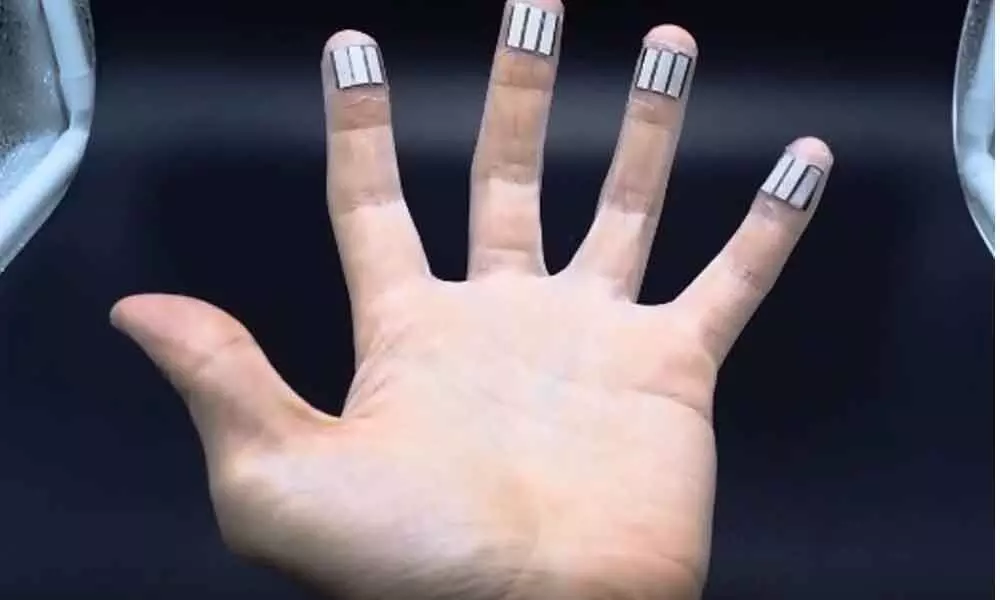Live
- CBI books Rajasthan narcotics inspector for Rs 3 lakh bribe
- Rajasthan bypolls: A tough contest between BJP and Congress
- Albania joins SEPA, paving way for EU integration
- Japanese government approves 250-billion USD economic package to ease price pain
- Six pharma companies to set up their units in Telangana
- The Unstable Events of a 17-Wicket Day in Perth: India vs Australia
- Dutch FM's Israel trip cancelled after Netanyahu's arrest warrant
- UK to increase energy price cap by 1.2 per cent
- Ethiopia launches national coffee platform to maximise earnings
- Centre completes auction of 3 coal blocks, to yield annual revenue of Rs 2,710 crore
Just In
The Next Generation Of Wearable Gadgets Could Be Powered By Sweating Fingertips


Wearable Gadgets
- The promises of a new breakthrough of a small, flexible device that wraps over your fingers like a Band-Aid and claims to be the most efficient sweat-powered energy harvester yet.
- Wearable sensors are now being developed by researchers all over the world to detect everything from a runner's acceleration to a diabetic's glucose levels.
Wearable sensors that measure glucose, vitamin C, and other health markers could be powered by the little beads of perspiration produced by your fingers while you sleep. That's the promise of a new breakthrough of a small, flexible device that wraps over your fingers like a Band-Aid and claims to be the most efficient sweat-powered energy harvester yet.
Roozbeh Ghaffari said that a biomedical engineer at Northwestern University who was not involved with the research and has the capacity to extract tiny volumes of sweat from the fingertips is truly unusual. Wearable sensors are now being developed by researchers all over the world to detect everything from a runner's acceleration to a diabetic's glucose levels.
However, the ability to power these sensors in a long-term manner is a significant barrier to their broad adoption. Solar electricity does not function at night, and batteries are heavy and short-lived. Researchers have recently turned their attention to the human body as a source of energy.
Meanwhile, sweat is a viable energy source as it contains lactate, a natural result of anaerobic respiration, the way by which your body obtains energy quickly when you exert yourself. Lactate may be broken down by an enzyme to produce energy.
Existing technologies, on the other hand, require a lot of perspiration to operate, and most people don't want to go to the gym every time their electronics run out of juice. As a result, Yin and his crew began to sweat their fingertip tips. Fingertips have the highest concentration of sweat glands on our bodies, even greater than the armpits, and they sweat consistently, regardless of how hard people work. Since perspiration evaporates nearly rapidly, it usually doesn't perceive it.
The new device is only 1 square centimeter broad and flexible enough to wrap around a fingertip, according to Joule. A stretchy hydrogel that lies on the skin absorbs sweat. The electrodes are three foam blocks placed on top of the gel. Two of them have an enzyme that draws electrons from lactate, while the other has platinum, which uses those electrons to turn oxygen into the water. The device that generates electricity generates a flow of electrons as a result of this operation.
During a night's sleep, the device can create 300 millijoules of energy per square centimeter, enough to run a wristwatch for a day. Furthermore, thanks to generators that convert mechanical energy into electricity, a person wearing the gadget may produce 30 millijoules per square centimeter by pressing two fingers together. The researchers showed that these brief bursts of energy can power a wearable vitamin C sensor and its display. However, wearable sensors are still in the early phases of development, but Ghaffari believes that research like this is helping to drive them closer to becoming a commonplace reality.

© 2024 Hyderabad Media House Limited/The Hans India. All rights reserved. Powered by hocalwire.com






